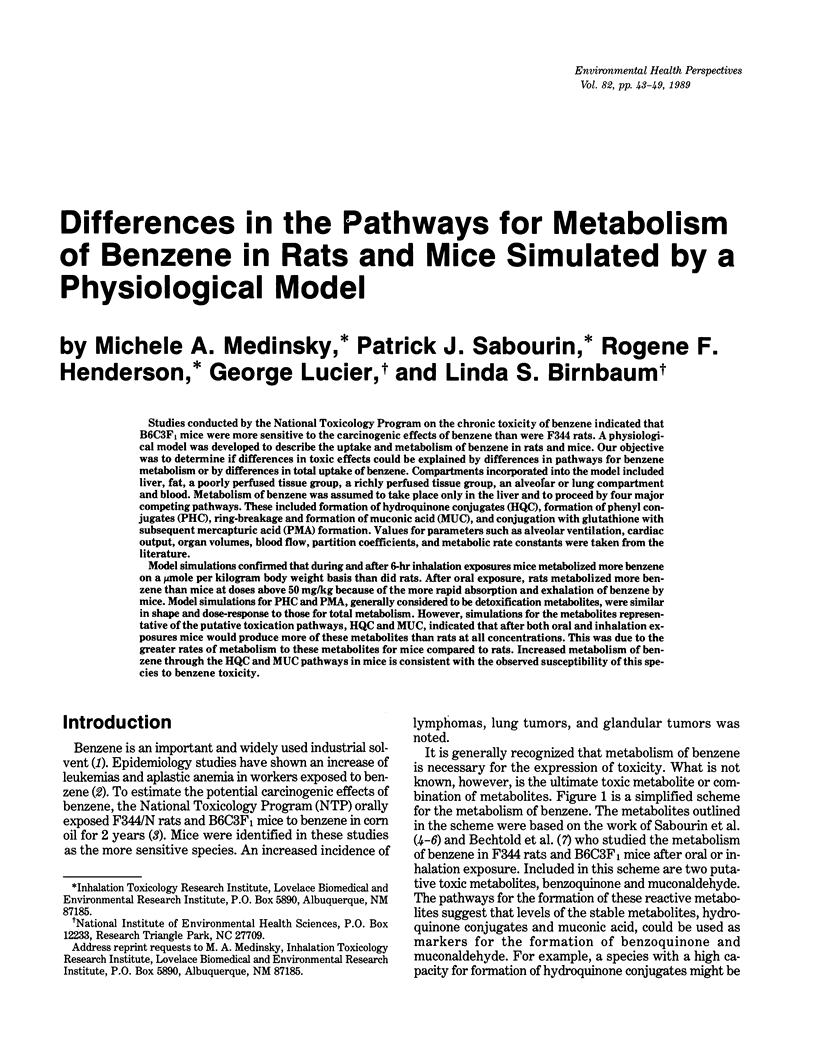Abstract
Studies conducted by the National Toxicology Program on the chronic toxicity of benzene indicated that B6C3F1 mice were more sensitive to the carcinogenic effects of benzene than were F344 rats. A physiological model was developed to describe the uptake and metabolism of benzene in rats and mice. Our objective was to determine if differences in toxic effects could be explained by differences in pathways for benzene metabolism or by differences in total uptake of benzene. Compartments incorporated into the model included liver, fat, a poorly perfused tissue group, a richly perfused tissue group, an alveolar or lung compartment and blood. Metabolism of benzene was assumed to take place only in the liver and to proceed by four major competing pathways. These included formation of hydroquinone conjugates (HQC), formation of phenyl conjugates (PHC), ring-breakage and formation of muconic acid (MUC), and conjugation with glutathione with subsequent mercapturic acid (PMA) formation. Values for parameters such as alveolar ventilation, cardiac output, organ volumes, blood flow, partition coefficients, and metabolic rate constants were taken from the literature. Model simulations confirmed that during and after 6-hr inhalation exposures mice metabolized more benzene on a mumole per kilogram body weight basis than did rats. After oral exposure, rats metabolized more benzene than mice at doses above 50 mg/kg because of the more rapid absorption and exhalation of benzene by mice. Model simulations for PHC and PMA, generally considered to be detoxification metabolites, were similar in shape and dose-response to those for total metabolism.(ABSTRACT TRUNCATED AT 250 WORDS)
Full text
PDF






Selected References
These references are in PubMed. This may not be the complete list of references from this article.
- Aksoy M., Erdem S. Followup study on the mortality and the development of leukemia in 44 pancytopenic patients with chronic exposure to benzene. Blood. 1978 Aug;52(2):285–292. [PubMed] [Google Scholar]
- Bechtold W. E., Sabourin P. J., Henderson R. F. A reverse isotope dilution method for determining benzene and metabolites in tissues. J Anal Toxicol. 1988 Jul-Aug;12(4):176–179. doi: 10.1093/jat/12.4.176. [DOI] [PubMed] [Google Scholar]
- Birnbaum L. S., Decad G. M., Matthews H. B. Disposition and excretion of 2,3,7,8-tetrachlorodibenzofuran in the rat. Toxicol Appl Pharmacol. 1980 Sep 15;55(2):342–352. doi: 10.1016/0041-008x(80)90096-4. [DOI] [PubMed] [Google Scholar]
- Dutcher J. S., Medinsky M. A., Bond J. A., Cheng Y. S., Snipes M. B., Henderson R. F., Birnbaum L. S. Effect of vapor concentration on the disposition of inhaled 2,3-dichloropropene in Fischer-344 rats. Fundam Appl Toxicol. 1985 Oct;5(5):997–1005. doi: 10.1016/0272-0590(85)90182-4. [DOI] [PubMed] [Google Scholar]
- Kalf G. F. Recent advances in the metabolism and toxicity of benzene. Crit Rev Toxicol. 1987;18(2):141–159. doi: 10.3109/10408448709089859. [DOI] [PubMed] [Google Scholar]
- Ramsey J. C., Andersen M. E. A physiologically based description of the inhalation pharmacokinetics of styrene in rats and humans. Toxicol Appl Pharmacol. 1984 Mar 30;73(1):159–175. doi: 10.1016/0041-008x(84)90064-4. [DOI] [PubMed] [Google Scholar]
- Sabourin P. J., Bechtold W. E., Birnbaum L. S., Lucier G., Henderson R. F. Differences in the metabolism and disposition of inhaled [3H]benzene by F344/N rats and B6C3F1 mice. Toxicol Appl Pharmacol. 1988 Jun 15;94(1):128–140. doi: 10.1016/0041-008x(88)90343-2. [DOI] [PubMed] [Google Scholar]
- Sabourin P. J., Bechtold W. E., Henderson R. F. A high pressure liquid chromatographic method for the separation and quantitation of water-soluble radiolabeled benzene metabolites. Anal Biochem. 1988 May 1;170(2):316–327. doi: 10.1016/0003-2697(88)90637-9. [DOI] [PubMed] [Google Scholar]
- Sabourin P. J., Chen B. T., Lucier G., Birnbaum L. S., Fisher E., Henderson R. F. Effect of dose on the absorption and excretion of [14C]benzene administered orally or by inhalation in rats and mice. Toxicol Appl Pharmacol. 1987 Feb;87(2):325–336. doi: 10.1016/0041-008x(87)90294-8. [DOI] [PubMed] [Google Scholar]


